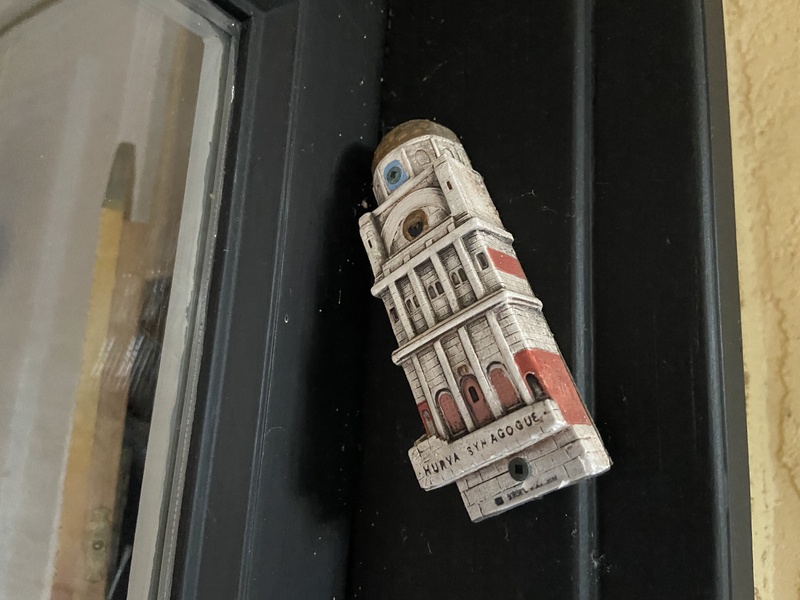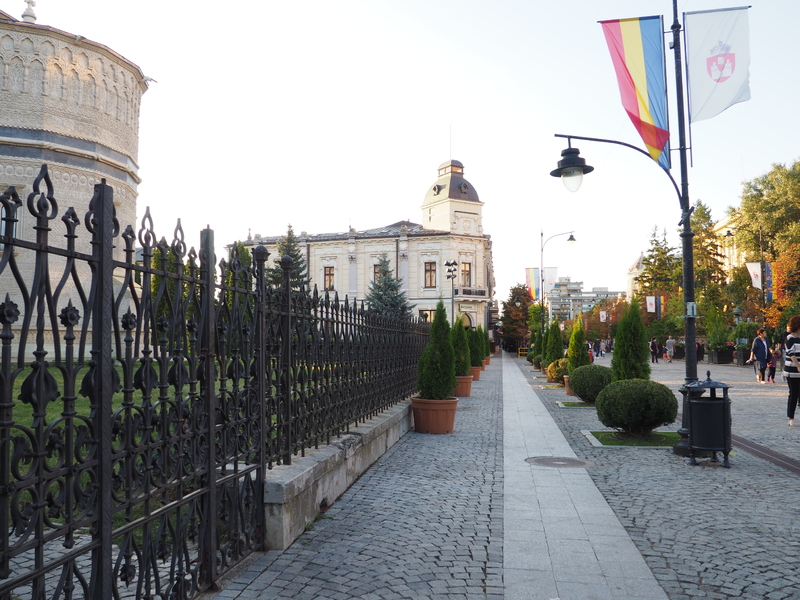Vanished Mezuzahs
The disturbing continued erasure of the Jews of Iași exists in both blatant and subtle measures. In a practice that continues today, Jews have marked their doorways with a mezuzah (see Figure 46). A mezuzah is a small, often beautifully crafted object marking the doorpost of the Jewish home. Within the mezuzah is a hand scribed parchment containing the sacred, central prayer of Judaism—the Shema Yisrael.
I walked down Strada Cuza Voda, the main street that winds through central Iași. A streetcar travels the length of the street, from the synagogue all the way up a number of miles to the University and beyond. I understood that the Jewish shops used to line the Strada Cuza Voda (S. Iosef, personal communication, September 2019). Stefana and I walked into a former Jewish residential neighborhood off of Strada Cuza Voda, and I looked for signs that this was a place where Jews had lived. In the courtyard children were playing ball, parents standing outside chatting in the friendly dusk evening. There were no marks or traces of mezuzahs on any doorposts and I wondered about the vanished past of the neighborhood.
The fact that only recently, mass graves have been discovered in Iași (Marinas, 2019) is evidence of the Romanians’ reluctance to face their past. I interviewed Serge Haber, a witness to the massacre of the Jews in Iași at the age of thirteen (personal communication with Serge Haber, October 25, 2019. Serge asked that I provide his testimony directly links to which are here, and here. As I walked down Strada Cuza Voda, there were no apparent markers on to commemorate the victims in 2019. Only the cemetery located a distance from town has a memorial monument, and by its distant nature this monument is hidden from the general population and the reality of the massacre is diminished though ignorance and silence. During the course of my meeting with Serge I showed photographs of a main boulevard in Iași. When Serge saw the photograph of the Trei Ierarhi Monastery Cathedral on Stefan Cel Mare Boulevard in central Iași, he suddenly exclaimed that after the massacre, the bodies were thrown into a ditch in front of that church (personal communication with Serge Haber, October 25, 2019). The boulevard is now paved over, without any mention of its history, into a beautiful pedestrian street. In the summer of 2019, before I knew Serge’s story, I walked on that boulevard on a warm summer evening and observed craft vendors displaying their ware. I listened for a time to a street musician sitting on a park bench expertly playing his accordion.
In Romania, I discovered an elaborate bureaucratic system of what felt like the withholding of documents, information, and archival materials. When I started to inquire about finding records about my own family I was advised the information I seek may only be found in the local National Archives offices for each municipality. Without knowledge of the Romanian language I was initially unable to make a request for documents; fortunately, I found a way to make a request with Stefana’s help, however there was no answer from the Archives. In the spring of 2022 I visited the Iași Archives’ reading room still hoping to find my grandmother’s birth certificate. I met animosity there, and the archivist told me bluntly “your information is bad, it is wrong” and eventually I had to leave frustrated. Thus, antisemitism and the continued oppression of the Jews of Romania exist in a callous bureaucracy, legal regulation, individual acts of violence and the suppression of evidence. This violence is acutely expressed by the abandonment of the almost hidden and deteriorating Cimitirul Evreiesc, the Jewish cemetery.
What led me to explore the cemetery in Iași to insist upon finding the grave of my great-great grandmother, and to walk in the heat and thorn bushes? Was there a strand in my unconscious of a previous generation’s troubles? What remains to me is the fact of my own experience. My exploration of the Cimitirul Evereiesc shifted my orientation and created a pivotal and vital moment in time and space. Merleau-Ponty wrote about such moments of dislocation as “the intellectual experience of disorder, but the vital experience of giddiness and nausea, which is the awareness of our contingency, and the horror with which it fills us” ((Merleau-Ponty, 1962, 254).
The story of my walk in the cemetery is not unique. It appeared to me that there may be almost daily Jewish visitors to the cemetery in Iași. Thousands of people were murdered in Iași and their relatives were evicted and expelled, ending up in varied, distant lands. Jews remain closely tied to their families and their ancestors. When a close relative dies, we may light a candle each year on the anniversary of their death. A special word in Yiddish, Yahrzeit exists for such a date and particular prayers are said on numerous occasions during the Jewish calendar year. When I visited my great-great grandmother’s grave, I had carried stones from Canada to place on her grave, mark my connection, to leave my message of love and remembrance. I believe the connection I felt in the cemetery was of warm greetings, that memories exist to be revived and that my task is one of resuscitation.

